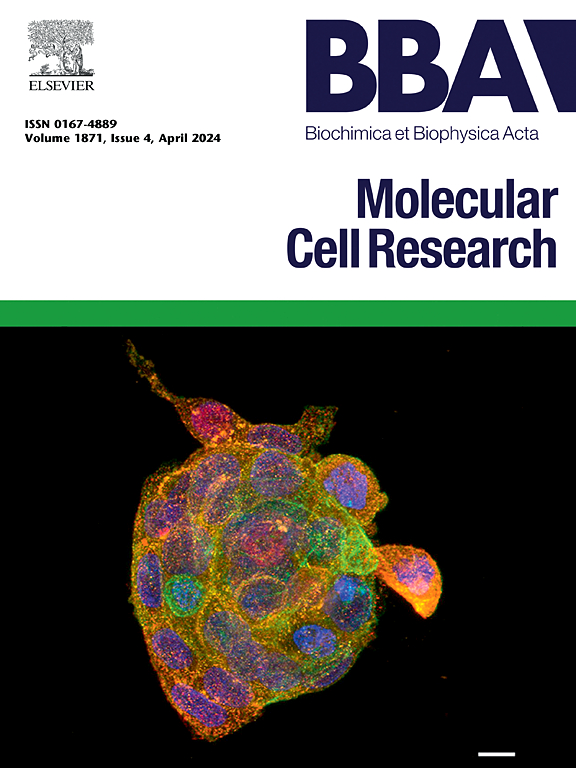非肌肉肌球蛋白 II Zipper 的缺失会导致果蝇细胞凋亡诱导的代偿性增殖。
IF 4.6
2区 生物学
Q1 BIOCHEMISTRY & MOLECULAR BIOLOGY
Biochimica et biophysica acta. Molecular cell research
Pub Date : 2025-03-27
DOI:10.1016/j.bbamcr.2025.119939
引用次数: 0
摘要
本文章由计算机程序翻译,如有差异,请以英文原文为准。

Loss of non-muscle myosin II Zipper leads to apoptosis-induced compensatory proliferation in Drosophila
Drosophila Non-muscle myosin II Zipper (Zip) belongs to a functionally divergent class of molecular motors that play a vital role in various cellular processes including cell adhesion, cell migration, cell protrusion, and maintenance of polarity via its cross-linking property with actin. To further determine its role in cell proliferation and apoptosis, we carried out Zip loss of function studies that led to compromised epithelial integrity in Drosophila wing imaginal discs as evident from the perturbed expression pattern of cell-cell junction proteins Cadherin, Actin, and Armadillo. Disruption of these adhesion proteins resulted in the cells undergoing apoptosis as evident from the increased level of effector caspase, cDcp-1. The induction of cell death due to the loss of function of Zip was accompanied by proliferation as apparent from increased PH3 staining. The control of apoptosis-induced compensatory proliferation lies under the caspase cascade. We carried out experiments that suggested that the apical caspase Dronc is responsible for the apoptosis-induced compensatory proliferation due to the loss of Zip function and not the effector caspase Drice/Dcp-1. Further, it was observed that Dronc leads to the subsequent activation of Jun N-terminal kinase pathway (JNK) pathway and Wingless (Wg) mitogen that diffuse to the neighboring cells and prompt them to undergo cell division. Taken together, our results suggest that loss of function of Zip leads to apoptosis-induced compensatory proliferation.
求助全文
通过发布文献求助,成功后即可免费获取论文全文。
去求助
来源期刊
CiteScore
10.00
自引率
2.00%
发文量
151
审稿时长
44 days
期刊介绍:
BBA Molecular Cell Research focuses on understanding the mechanisms of cellular processes at the molecular level. These include aspects of cellular signaling, signal transduction, cell cycle, apoptosis, intracellular trafficking, secretory and endocytic pathways, biogenesis of cell organelles, cytoskeletal structures, cellular interactions, cell/tissue differentiation and cellular enzymology. Also included are studies at the interface between Cell Biology and Biophysics which apply for example novel imaging methods for characterizing cellular processes.

 求助内容:
求助内容: 应助结果提醒方式:
应助结果提醒方式:


